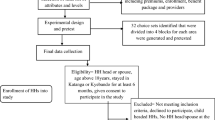Abstract
Background
In many countries, health insurance coverage is the primary way for individuals to access care. Governments can support access through social insurance programmes; however, after a certain period, governments struggle to achieve universal coverage. Evidence suggests that complex individual behaviour may play a role.
Objectives
Using a choice experiment, this research explored consumer preferences for health insurance in Colombia. We also evaluated whether preferences differed across consumers with differing demographic and health status factors.
Methods
A household field experiment was conducted in Bogotá in 2010. The sample consisted of 109 uninsured and 133 low-income insured individuals. Each individual evaluated 12 pair-wise comparisons of hypothetical health plans. We focused on six characteristics of health insurance: premium, out-of-pocket expenditure, chronic condition coverage, quality of care, family coverage and sick leave. A main effects orthogonal design was used to derive the 72 scenarios used in the choice experiment. Parameters were estimated using conditional logit models. Since price data were included, we estimated respondents’ willingness to pay for characteristics.
Results
Consumers valued health benefits and family coverage more than other attributes. Additionally, differences in preferences can be exploited to increase coverage. The willingness to pay for benefits may partially cover the average cost of providing them.
Conclusion
Policy makers might be able to encourage those insured via the subsidized system to enrol in the next level of the social health insurance scheme through expanding benefits to family members and expanding the level of chronic condition coverage.





Similar content being viewed by others
Notes
For a detailed description of the two tiers, please see table S1 in the Supplemental Digital Content (SDC), http://links.adisonline.com/APZ/A47.
For a more in-depth description, please see table S1 in the SDC.
For public policy purposes (e.g. calculation of subsidies in public services, welfare programme aids, property taxes, etc.), geographic areas in Bogota are classified in stratum based on a scale from 1=poorest to 6=richest.
We feel that these populations are different and need to be estimated separately. However, we tried the analysis with the pooled sample and the results were similar.
For the analysis of the heterogeneity, we considered taking all the four variables in one specification, but most of the interactions were not significant and were hard to interpret. As such, we decided to run separate regressions.
References
Wagner AK, Graves AJ, Reiss SK, et al. Access to care and medicines, burden of health care expenditures, and risk protection: results from the World Health Survey. Amsterdam: Health Policy, 2010
Hadley J. Sicker and poorer — the consequences of being uninsured: a review of the research on the relationship between health insurance, medical care use, health, work, and income. Med Care Res Rev 2003; 60(2 Suppl.): 3S–75S; discussion 76S-112S
Institute of Medicine. America’s uninsured crisis: consequences for health and health care. Consensus report, 2009 [online]. Available from URL: http://www.iom.edu/Reports/2009/Americas-Uninsured-Crisis-Consequences-for-Health-and-Health-Care.aspx [Accessed 2010 Jun 3]
Giedion U, Uribe MV. Colombia’s universal health insurance system. Health Aff (Millwood), 2009; 28(3): 853–63
Amaya Lara JL, Ruiz Gómez F. Determining factors of catastrophic health spending in Bogota, Colombia. Int J Health Care Finance Econ 2011; 11(2): 83–100
Trujillo A, Portillo J, Vernon J. The impact of subsidized health insurance for the poor: evaluating the Colombian experience using propensity score matching. Int J Health Care Finance Econ 2005; 5(3): 211–39
Trujillo A, McCalla D. Are Colombian sickness funds cream-skimming enrollees? An analysis with suggestions for policy improvement. J Policy Anal Manage 2004; 23(4): 873–88
Glassman AL, Escobar M-L, Giuffrida A, et al. From few to many: ten years of health insurance expansion in Colombia. Washington, D.C.: Inter-American Development Bank-The Brooking Institution Press, 2009
Trujillo A. Medical care use and selection in a social health insurance with an equalization fund: evidence from Colombia. Health Econ 2003; 12(3): 1–17
Chakraborty G, Ettenson R, Gaeth G. How consumers choose health insurance. J Health Care Market 1994; 14: 21–33
Royalty AB, Solomon N. Health plan choice: price elasticities in managed competition settings. J Hum Resour 1999; 34(1): 1–41
Kerssens JJ, Groenewegen PP. Consumer preferences in social health insurance. Eur J Health Econ 2005; 50: 8–15
Becker K, Zweifel P. Age and choice in health insurance. Patient 2008; 1:27–40
Telser H, Zweifel P. Measuring willingness-to-pay for risk reduction: an application of conjoint analysis. Health Econ 2002; 11: 129–39
Harris KM. Can high quality overcome consumer resistance to restricted provider access? Evidence from a health plan choice experiment. Health Serv Res 2002; 37(3): 551–71
Phillips KA, Maddala T, Johnson FR. Measuring preferences for health care interventions using conjoint analysis: an application to HIV testing. Health Serv Res 2002; 37(6): 1681–705
Schut FT, Gress S, Wasem J. Consumer price sensitivity and social health insurance choice in Germany and the Netherlands. Int J Health Care Finance Econ 2003; 3: 117–28
van den Berg B, Van Dommelen P, Stam P, et al. Preferences and choices for care and health insurance. Soc Sci Med 2008; 66: 2448–59
Vroomen JM, Zweifel P. Preferences for health insurance and health status: does it matter whether you are Dutch or German? Eur J Health Econ 2011; 12(1): 87–95
Thurstone LL. A law of comparative judgement. Psychol Rev 1927; 34: 273–86
Lancaster K. A new approach to consumer theory. J Polit Econ 1966; 74: 132–57
Manski CF. The structure of random utility models. Theory Decis 1977; 8: 229–54
McFadden D. Conditional Logit analysis of qualitative choice behavior. In: Zaremba Paul, editor. Frontiers in econometrics. New York: Academic Press, 1974: 105–42
Bridges JFP. Stated preference methods in health care evaluation: an emerging methodological paradigm in health economics. Appl Health Econ Health Policy 2003; 2(4): 213–24
de Bekker-Grob EW, Ryan M, Gerard K. Discrete choice experiments in health economics: a review of the literature. Health Econ. Epub 2010 Dec 19
Hensher DA, Rose JM, Greene WH. Applied choice analysis: a primer. Cambridge: Cambridge University Press, 2005
Booske BC, Sainfort F, Schoofs HA. Eliciting consumer preferences for health plans. Health Serv Res 1999; 34(8): 839–54
Gyrd-Hansen D, Slothuus U. The citizen’s preferences for financing public health care: a Danish survey. Int J Health Care Finance Econ 2002; 2: 25–36
Huber J, Zwerina K. The importance of utility balance in efficient choice designs. J Market Res 1996; 33(3): 307–17
Street DJ, Burgess L. The construction of optimal stated choice experiments: theory and methods. Hoboken (NJ): Wiley-Interscience, 2007
Bridges J, Hauber AB, Marshall D, et al. A checklist for conjoint analysis applications in health: report of the ISPOR Conjoint Analysis Good Research Practices Task-force. Value Health 2011; 14(4): 403–13
Ryan M, Scott DA, Reeves C, et al. Eliciting public preferences for healthcare: a systematic review of techniques. Health Technol Assess 2001; 5(5): 1–186
Chrzan K, Orme B. An overview and comparison of design strategies for choice-based conjoint analysis. Sawtooth Software Research Paper Series. Sequim (WA): Sawtooth Software, Inc., 2000
Louviere J, Woodworth G. Source design and analysis of simulated consumer choice or allocation experiments: an approach based on aggregate data. J Market Res 1983; 20(4): 350–67
Sandor Z, Wedel M. Designing conjoint choice experiments using managers’ prior beliefs. J Market Res 2001; 38: 430–44
Kanninen BJ. Optimal design for multinomial choice experiments. J Market Res 2002; 39(2): 214–27
Burgess L. Discrete choice experiments [computer software]. Sydney: Department of Mathematical Sciences, University of Technology, 2007 [online]. Available from URL: http://crsu.science.uts.edu.au/choice/ [Accessed 2011 Nov 1]
Cendex. Encuesta Nacional de Salud Colombia 2007. Ministerio de la Protección Social, Colciencias, Javegraf, 2009
Stata Corporation. Stata statistical software: version 10. Reference volumes. College Station (TX): STATA Corporation, 2008
Orme BK. Getting started with conjoint analysis: strategies for product design and pricing research. Madison (WI): Research Publishers LLC, 2006
Slothuus Skjoldborg U, Gyrd-Hansen D. Conjoint analysis. The cost variable: an Achilles’ heel? Health Econ 2003 Jun 1; 12(6): 479–91
Howard K, Salkeld G. Does attribute framing in discrete choice experiments influence willingness to pay? Results from a discrete choice experiment in screening for colorectal cancer. Value Health 2009; 12(2): 354–63
Acknowledgements
This project was financed by Asocajas, Fundación Corona and Gestar Salud as a part of the project “New Strategies for Health Universalization in Colombia”. The authors have no conflicts of interest that are directly relevant to the content of this article.
Author information
Authors and Affiliations
Corresponding author
Rights and permissions
About this article
Cite this article
Trujillo, A.J., Ruiz, F., Bridges, J.F.P. et al. Understanding consumer preferences in the context of managed competition. Appl Health Econ Health Policy 10, 99–111 (2012). https://doi.org/10.2165/11594820-000000000-00000
Published:
Issue Date:
DOI: https://doi.org/10.2165/11594820-000000000-00000




